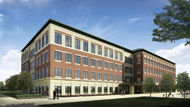| COVER STORY, SEPTEMBER 2010
HUNTING FOR MEDICAL OFFICE FUNDING
Finding money for MOBs is challenging, but it can be done.
Jeff Brown
It’s a familiar refrain: private capital for real estate development is practically impossible to get. That conventional wisdom is just as true for medical multi-purpose and office buildings as it is for retail and commercial projects. But for those willing to invest significant time, energy and money to assemble deals that eliminate virtually all the risk that was so common just a few years ago, there is, in fact, plenty of capital available. Those in control of that money are more than eager to get it off the sidelines and put it into play.
 |
The Texas A&M Health Science Center Medical Office Building in Bryan.
|
|
What are the keys to making the deal happen? Patience, persistence and tenants with excellent credit who are willing to partner with you to make it work are important. The Texas A&M Health Science Center Medical Office Building now under construction in Bryan is a case in point. This 130,000-square-foot, Class A building, which is set for completion next summer, represents a truly unique public-private partnership. It also provides valuable lessons for anyone struggling to make a medical office project happen in this challenging financial environment.
Lesson 1: Tenant Mix
The tenants in the new Texas A&M building form a diverse cross-section of medical organizations, but, more important, each has great credit. Their commitments to be a part of the project made it possible to negotiate very favorable debt financing and helped attract equity investment in the project. In short, great tenants with great credit mean lower risk for lenders and investors. In today’s economy, reducing risk is Job One.
Lesson 2: A Strong Developer
One key factor in attracting tenants, investors and lenders is a developer with very deep resources. Investors, tenants and lenders are searching for the comfort of low-risk deals; that’s the result of the financial turmoil of the past couple of years. Knowing that a big, credible player with an impeccable balance sheet is backing the deal goes a long way to providing all the players with good reason to believe their risk is minimized.
Of course, it’s not easy to assemble a deal that is virtually risk-free. That’s why Lesson 3 is critical.
Lesson 3: Patience
If it were easy, this kind of project would be popping up all over, but it’s not easy. It takes time, patience and persistence. You have to be willing to invest the time – likely a year or more – to build the relationships necessary to gain the commitments of high-quality tenants, investors and lenders. Keeping in mind that prospective medical office tenants are just as nervous as anyone else about the future, many of them will not be willing to commit to moving into your building. The more you can credibly demonstrate that you have absolutely minimized risk and that the project is on very solid financial ground, the more likely your prospective tenants will be to sign on. In turn, these commitments will impress investors and lenders.
If you’re the developer, you still have risk, of course, because you’re the one who has to invest a year or more of time to build the relationships and pull all the parties together. The payoff, however, thanks to all of this heavy lifting up front, will be a project with very little risk once all the contracts are signed.
The medical office building market is ripe for more public-private partnerships. State governments, public universities and healthcare systems are all running very short on capital and have little or no borrowing capacity. A creative, well-planned public-private partnership gets them the new buildings they need and they become tenants rather than owners, which keeps the costs off their balance sheets. It’s a great way to provide these institutions with access to capital at a time when many of them have no other options.
— Jeff Brown is a partner with Skanska HealthRealty and is based in College Station.
©2010 France Publications, Inc. Duplication
or reproduction of this article not permitted without authorization
from France Publications, Inc. For information on reprints of
this article contact Barbara
Sherer at (630) 554-6054.
|
